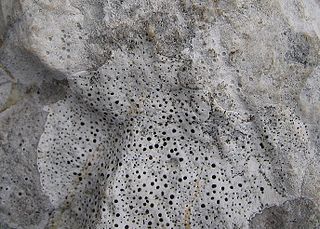
Verrucariales is an order of ascomycetous fungi within the subclass Chaetothyriomycetidae of the class Eurotiomycetes. Although most of the Verrucariales are lichenised, the family Sarcopyreniaceae consists of 11 species of lichenicolous (lichen-dwelling) fungi.

Verrucariaceae is a family of lichens and a few non-lichenised fungi in the order Verrucariales. The lichens have a wide variety of thallus forms, from crustose (crust-like) to foliose (bushy) and squamulose (scaly). Most of them grow on land, some in freshwater and a few in the sea. Many are free-living but there are some species that are parasites on other lichens, while one marine species always lives together with a leafy green alga.

Dermatocarpon is a genus of lichens in the family Verrucariaceae.
Scleropyrenium is a genus of squamulose (scaly) lichens in the family Verrucariaceae. It has two species. The genus was circumscribed in 1993 by Japanese lichenologist Hiroshi Harada, with S. japonicum as the type species. Characteristics of the genus include a dark brown to almost black exciple, pycnidia of the Staurothele-type, and a pachydermatous upper cortex.

A lichenicolous fungus is a parasitic fungus that only lives on lichen as the host. A lichenicolous fungus is not the same as the fungus that is the component of the lichen, which is known as a lichenized fungus. They are most commonly specific to a given fungus as the host, but they also include a wide range of pathogens, saprotrophs, and commensals.
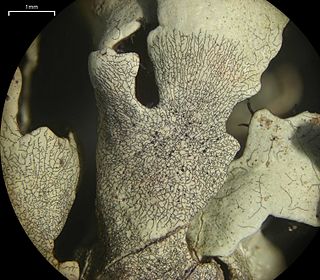
Lichenostigma cosmopolites is a species of lichenicolous fungus belonging to the family Phaeococcomycetaceae. It was described as new to science in 1999 by lichenologists Josef Hafellner and Vicent Calatayud. The fungus grows parasitically on Xanthoparmelia lichens. In India it has been reported from the thallus of Xanthoparmelia stenophylla.
Taitaia is a single-species fungal genus in the family Gomphillaceae. It was circumscribed in 2018 to contain the species Taitaia aurea, a lichenicolous (lichen-dwelling) fungus. This species is characterized by aggregated ascomata with yellow margins, and salmon-red discs that originate from a single base. It is known only from a few sites in Kenya's tropical lower-mountain forests, where it grows on thalli of the lichen Crocodia.
Briancoppinsia is a fungal genus in the family Arthoniaceae. It is monotypic, containing the single species Briancoppinsia cytospora, a lichenicolous fungus that parasitises parmelioid lichens, as well as Cladonia, Lepra, and Lecanora conizaeoides, among others. The species was first described scientifically by Léon Vouaux in 1914 as Phyllosticta cytospora. The genus was circumscribed in 2012 by Paul Diederich, Damien Ertz, James Lawrey, and Pieter van den Boom. The genus was named for Brian John Coppins, who is, according to the authors, an "eminent British lichenologist and expert of lichenicolous fungi".
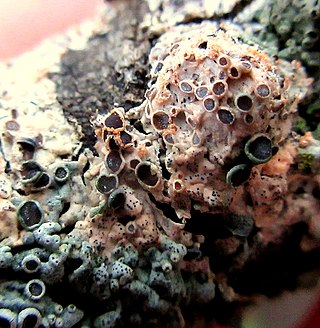
Ovicuculispora parmeliae is a widely distributed species of lichenicolous fungus in the family Bionectriaceae. It is parasitic on many foliose lichen species, particularly those in the family Parmeliaceae.
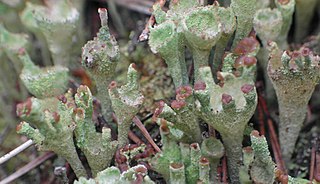
Cladonia pyxidata or the pebbled cup lichen is a species of cup lichen in the family Cladoniaceae. It is host to the lichenicolous fungus Lichenoconium pyxidatae.
Ave Suija is an Estonian lichenologist. As at 2024 she works for the University of Tartu. The lichenicolous fungus species Capronia suijae was named in her honour in 2017.

Muellerella pygmaea is a species of lichenicolous fungus in the family Verrucariaceae. It has a cosmopolitan distribution in Arctic-alpine areas and grows on the thallus and apothecia of a number of hosts.
Xenonectriella subimperspicua is a species of lichenicolous fungus in the family Nectriaceae. It has been recorded from South America, Europe, and New Zealand.
Endococcus hafellneri is a species of lichenicolous (lichen-eating) fungus in the family Verrucariaceae. It is found in North Asia and the Russian Far East, Estonia, and Japan, where it grows on the lobes of the lichens Flavocetraria cucullata and Cetraria islandica.
Graphium samogiticum is a little-known species of lichenicolous (lichen-eating) fungus in the family Microascaceae. It is found in Lithuania, where it parasitises two lichen species that inhabit abandoned gravel pits.
Phoma candelariellae is a species of lichenicolous (lichen-eating) fungus in the family Didymellaceae. It is found in the Central Anatolia Region of Turkey and in Ukraine, where it grows parasitically on the apothecia of the saxicolous (rock-dwelling) lichen Candelariella aurella.
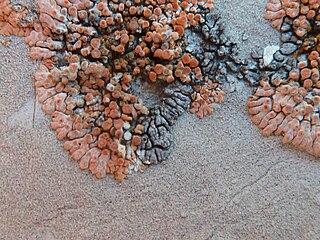
Verrucula is a genus of lichenicolous (lichen-dwelling) lichens in the family Verrucariaceae. Species in the genus are parasitic on saxicolous (rock-dwelling), crustose lichens, including Xanthoria elegans as well as lichens from genus Caloplaca that contain chemical substances called anthraquinones.
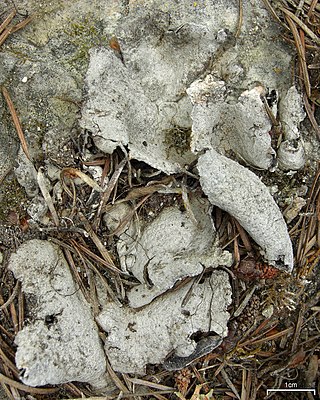
Dermatocarpon atrogranulosum, commonly known as the charred stippleback, is a species of saxicolous (rock-dwelling) lichen in the family Verrucariaceae. It is found in a few locations in British Columbia, Canada, where it grows on limestone outcrops. It was formally described as a new species in 2003 by Austrian lichenologist Othmar Breuss. It is one of 24 Dermatocarpon species known to occur in northern North America.
Pyrenidium is a genus of lichenicolous (lichen-dwelling) fungi. It is the only genus in the family Pyrenidiaceae. It has 13 species.
Endococcus thelommatis is a species of lichenicolous (lichen-dwelling) fungus in the family Lichenotheliaceae. It was formally described as a new species in 2011 by lichenologists Jana Kocourková and Kerry Knudsen. The fungus grows on the lichen Thelomma santessonii, a common saxicolous (rock-dwelling), crustose lichen that is endemic to the coast and islands of Southern California and Mexico's Baja California. Endococcus thelommatis is the first lichenicolous fungus to have been reported from this lichen.










